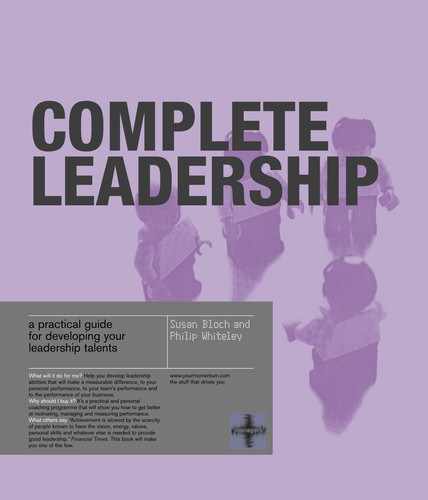democratic and more coercive than he sees himself; however, this is
not a great cause for concern in this particular example. Andy is
genuinely supportive of his team – as demonstrated by the high
scores he receives under the ‘affiliative’, ‘democratic’ and ‘coaching’
headings. This indicates that he is a ‘nice guy’ who has made it to the
top. For such individuals, the power and status of a senior role are
not the main attraction; they value the personal qualities they have
retained, and so naturally tend to underestimate the effect that the
impact of being ‘the boss’ has on other individuals. When he
suggests that the team does something, he can believe he has been
affiliative in style, but because he is ‘the controller’, at least some of
his team interpret it as an order. Hence the higher score under the
‘coercive’ heading than he would give himself. This is a common
dynamic and, provided the gap between the real and perceived
attribute in this area is not too great, it is not a cause for concern.
Indeed, there is a more even spread of leadership styles in the
feedback from his team, than in his own perception; indicating that
he is a more balanced leader than he himself realizes.
The coercive style is still low (it probably would have been higher
earlier in his realm as controller – see Chapter 8). As indicated in the
discussion of the coercive style above, he would probably not want to
increase his score here. Andy works in the creative business, for the
market leader in popular music radio in the UK, the employer of choice
for every DJ in the country. He is not going to be working with people
who lack motivation. He is nurturing people with considerable creative
talent and in some cases massive egos. This requires intelligence,
sensitivity and a good range of emotionally intelligent skills.
Beliefs drive behaviour (and an example of how
workaholic beliefs can distort our perceptions)
Beliefs are very powerful things in our lives, and behaviour is
organized around beliefs. Often to help us change some of our
behaviours we need to examine our beliefs and values systems,
otherwise behaviour change is superficial.
It is our contention that everyone possesses beliefs and is guided by
them. It is also our contention that beliefs can change. You are not
born with them. We have all believed things when we were young
which we now look back on and consider rather stupid, and certainly
not helpful today. We are not just talking about Santa Claus or the
tooth fairy. We can feel embarrassed, for example, about a rather
extreme political stance that we adopted while at university.
But some of the most pervasive beliefs that matter to how we
manage do not lie within the realm of legend or philosophy or
politics, but relate to our views on work, families and careers, some
of which we discussed in Chapter 2. Imagine if, for example, you had
grown up to believe that all women who are married with children
should not work full time until their children leave home. How
would you feel then moving into a role where your new boss is a
woman with three children all under the age of 11? Or you might
believe that people only get somewhere in life by ‘working hard’ and
‘doing it all yourself’. In our experience, we have certainly met many
executives who are workaholics and who struggle to build strong
teams beneath them.
Poor self-awareness of a pace-setting boss
Bob (not his real name) had a very strong belief that in order to be a
successful manager you should be fair and very firm, but certainly
not friendly. In fact he believed that if people liked you, found you
empathetic, and you took an interest in them and their careers, you
were bound to be a ‘poor’ leader. He developed a management style
that was dominantly coercive and pace-setting. He had had feedback
over a two-year period that as a partner in a large legal firm more
junior professionals were not keen to work with him, despite the fact
that he usually sold the most interesting assignments.
His clients thought his work was exceptional, so the firm realized it
had to deal with the problem before he hit burnout. To deal with
high staff turnover in his team, Bob worked long hours and did a lot
of the technical work himself. Most of the time he was exhausted. His
management style and climate data showed a large gap in how he
momentum complete leadership chapter five
93
pages 92 /

perceived himself, and how his team perceives him (see the charts on
pages 95 to 100). He saw himself as authoritative and democratic;
they saw him as coercive and pace-setting.
Data on the climate and mood he created around him showed low
team co-operation, and reward, and poor clarity and standards. No
wonder poor Bob had to work so hard. Importantly, Bob had had
similar feedback for three years running now and had still not
changed. He did try from time to time, but kept slipping back to old
habits. Only when he worked through D-3 of the 3-D model (see
page 107) was he able to reframe his beliefs and begin to work on
changing his behaviour. Not only did the performance in his team
improve but contribution of his team to the profits margin of the firm
increased by 8 per cent.
The charts we have discussed of Andy Parfitt and of Bob give a vivid
and comprehensive picture of our level of self-awareness derived
from a relatively simple questionnaire process. Remember, this is an
established process, not just a theory, and it has been used to help
thousands of managers improve their performance. They show how
Andy had a strong level of self-awareness and that, initially, Bob did
not. The point to emphasize here, however, is that self-awareness is
an improvable ability, like any human skill. Bob had the integrity
and honesty to work hard on this aspect of himself; specifically
confronting his deeply embedded belief, which he had probably
carried since childhood, that empathy and friendliness were
incompatible with leadership. This belief had stymied his self-
awareness and his growth as a leader. It had caused him to consider
himself more authoritative than was experienced by his team, but he
did possess the courage to challenge this belief, leading to the
improved performance of his team, and ultimately to better business
results.
To deal with high staff turnover in his team, Bob
worked long hours and did a lot of the technical work
himself. Most of the time he was exhausted.

momentum complete leadership chapter five
95
pages 94 /
100
90
80
70
60
50
40
30
20
10
0
100
90
80
70
60
50
40
30
20
10
0
9.9
Coercive Authoritative Affiliative Democratic Pace-setting Coaching
70.2
61
97.6
50.3
56.8
Percentiles
66 = Dominant
50–65 = Backup
Management style inventory (Participant version)
Source:
Hay Group, 2002

100
90
80
70
60
50
40
30
20
10
0
100
90
80
70
60
50
40
30
20
10
0
60.6
Coercive Authoritative Affiliative Democratic Pace-setting Coaching
13.5
8.9
42.4
95.1
12.5
Percentiles
66 = Dominant
50–65 = Backup
Management style inventory (Employee version (N = 6))
Source:
Hay Group, 2002
..................Content has been hidden....................
You can't read the all page of ebook, please click here login for view all page.
